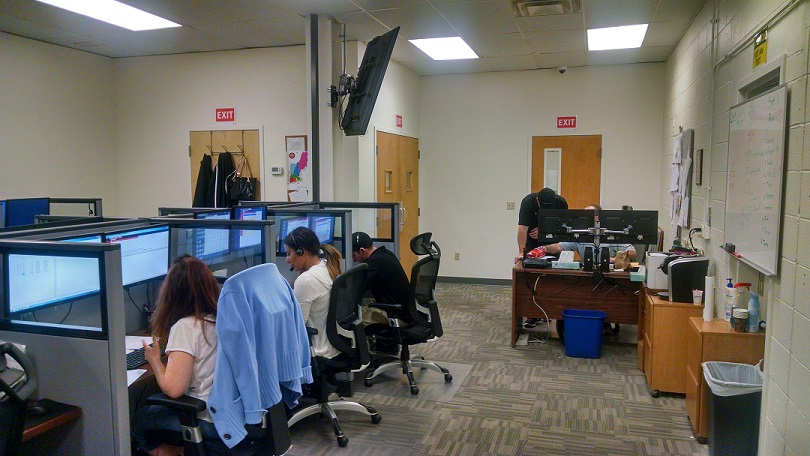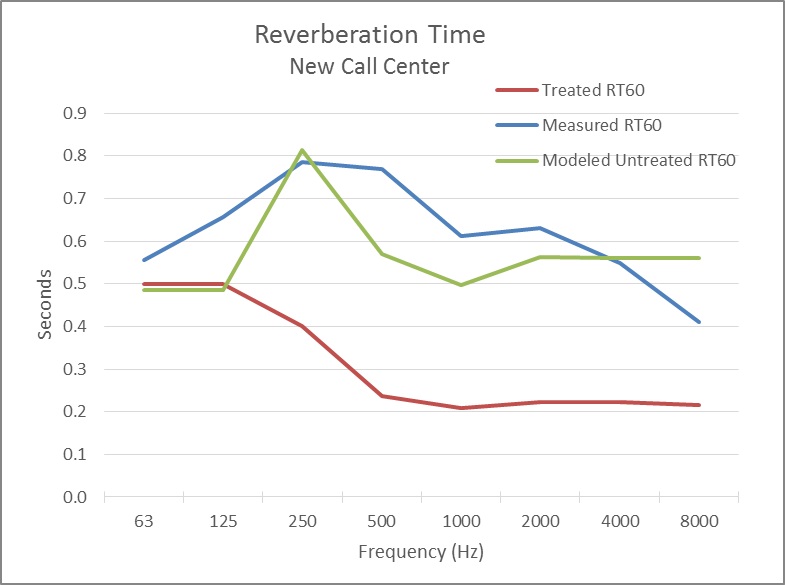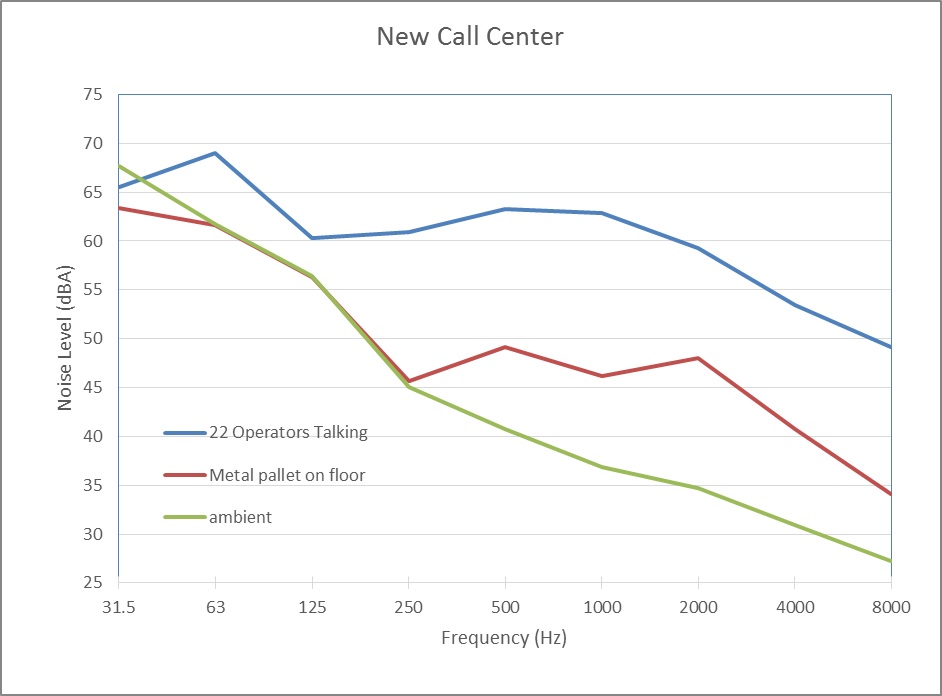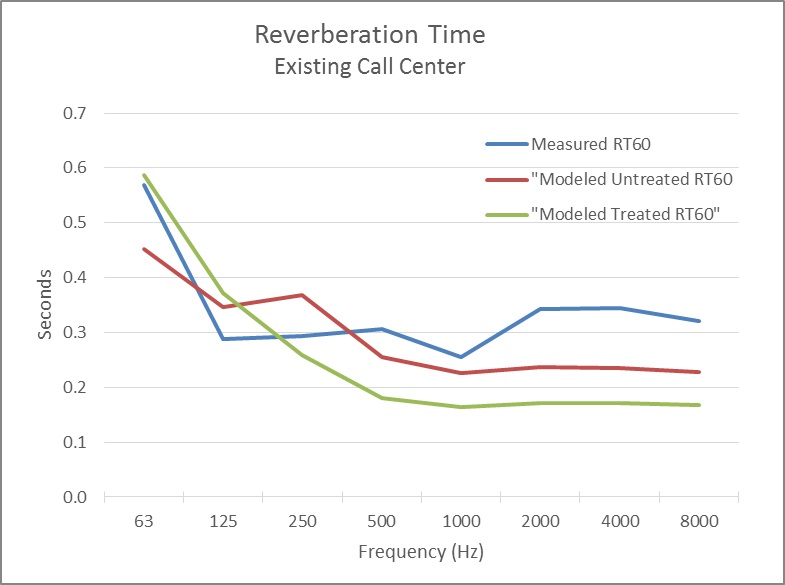
Introduction
David Coate Consulting (DCC) conducted a sound study to assess the room acoustics of Town Fair Tire’s new call center (under construction) as well as the smaller existing call center currently in operation (shown in the photo above). Specifically, this study evaluates the effects of reverberation within each space as well as the potential for modifying the architectural finishes to achieve better listening conditions and verbal communication of headset telephone operators. “Reverberation” refers to the effect of multiple reflections off of various surfaces combining at a listener location. Excessive reverberation results in a lack of speech intelligibility. The acoustical measure of reverberation is called the RT60, which is the time in seconds it takes for a short impulsive sound to decay (diminish) by 60 decibels.
New Call Center
Reverberation Control and Treatments
The reverberation time (RT60) of the new call center was measured using a high performance sound system and pink noise bursts. Figure 1 shows the measured RT60 values in octave frequency bands. Using the room dimensions and absorption data associated with the existing architectural finishes, a room acoustics model was developed to calculate the RT60. This data is also shown in Figure 1 as “Modeled Untreated RT60.” The model and measurements are within 0.2 seconds or less of each other, so the model can be used with confidence to audition the performance of absorptive treatments.

It was assumed that a thick carpet pad and carpet would completely cover the floor, and 60% of the walls would be covered with 2” thick Owens corning 703 semi-rigid fiberglass panels. The panels would be covered with acoustically transparent and fire-retardant fabric. The model was modified with these assumptions and the resulting RT60 values are shown in Figure 2. This reduction in reverberation would have a very beneficial effect on speech intelligibility and would result in a small decrease in noise levels within the space.
For example, assuming only a 3 dB signal to noise ratio between speech and background noise (worst case scenario assuming very noisy conditions with normal conversation), this treatment would improve the Speech Transmission Index (STI) from 0.64 to 0.75. In other words, given these extreme assumptions, the amount of speech understood would increase from 64% to 75%. However, assuming a relatively high signal to noise ratio (affected by ambient noise levels but greatly benefitted by headset communication), the STI would increase from 0.85 to 0.95. In other words, headset communication is not nearly affected by background noise as is normal speech communication between two people in the same room.
Our model indicates that noise levels within the call center would be reduced by approximately 2 to 2.5 decibels with this treatment. This is a small amount of noise reduction, which is expected given that the untreated space would have to be highly reverberant to realize larger amounts of noise reduction via absorption treatments. It is important to note that absorptive treatments such as the fiberglass and carpet will do very little to reduce noise entering into the space from the warehouse area. Only the addition of mass and de-coupling (described later) can reduce this noise.

Figure 2. Figure 2. Noise Levels in New Call Center
Noise Control and Treatments
In order to predict call operator noise levels in the new call center, noise measurements of operators talking were conducted in the existing call center and extrapolated to the new call center. Extrapolated operator noise levels were computed on the basis of up to 22 operators talking versus 7 operators measured in the existing call center. This data is also shown in Figure 2 for comparison with ambient noise levels. In the important mid frequencies for speech, there is a 20+ dB signal to noise ratio which means that normal ambient noise will not significantly interfere with speech. Next, various tests in the warehouse were conducted including sounding fork lift warning bells, dropping metal pallets on a truck bed, and dragging metal pallets on the concrete floor.
The highest measured noise spectrum was dragging the metal pallets on the floor and is also shown in Figure 2. When this sound occurs, the speech signal to noise ratio will be reduced to approximately 14 dB, so speech will still be intelligible but not ideal for a call center.
Testing and analysis of the new call center walls, floors, and ceiling was not in our scope of services with respect to sounds from the warehouse penetrating the space. Transmission Loss (TL) tests of such partitions are usually performed to determine the performance of the partitions and the amount of needed improvement. In spite of not knowing how much improvement would be needed, the basic idea is to add more mass and decoupling to partitions. This is usually done by adding extra layers of Gypsum Wall Board (GWB) and in some cases mounting the GWB resiliently to improve the TL of the walls, floor, and ceiling. The TL of the windows overlooking the warehouse could be improved by either replacing them with GWB or by creating an airspace with an additional lite of laminated glass.
Existing Call Center
The existing call center is a relatively small space and therefore reverberation is not particularly an issue. However, some improvements could be made by adding more acoustical absorption to the space. Figure 3 shows measured RT60 compared with modeled untreated RT60. These values are within 0.1 seconds of each other, so the room model can be used to accurately predict the RT60 with treatments.

Figure 3. Existing Call Center- Measured and Modeled RT60
It was assumed that 50% of the walls would be covered with 2” thick Owens corning 703 semi-rigid fiberglass panels. The panels would be covered with acoustically transparent and fire-retardant fabric. The model was modified with these assumptions and the resulting RT60 values are shown in Figure 2. Assuming quiet conditions, the STI would increase from 0.97 to 0.98 with this treatment. This improvement in speech intelligibility would be hardly noticeable and therefore adding the acoustical absorption to this space may not make sense.
Cubicles
It is assumed that cubicles similar to those in the existing call center will be installed in the new call center. Speech privacy between operators is governed by a number of factors including the barrier effect of the cubicles as well as the acoustical absorption treatment built into the cubicles. The greater the height and depth of cubicles, the greater will be speech privacy.
Summary of Treatment Recommendations
In summary, good speech intelligibility in the new call center will require the installation of 2” thick Owens Corning 703 semi-rigid fiberglass panels covering at least 60% of the GWB walls. The panels would be covered with fire-rated acoustically transparent fabric such as manufactured by Guilford of Maine Fabrics. The floor should be covered with a thick pad and thick carpet (i.e., not industrial carpet).
Pre-made acoustical panels may be purchased, but will be much more expensive than fabricating them on-site. Fabrication on site also has the advantage of creating large contiguous areas of treatment, hidden behind acoustical fabric. The acoustical fabric can be made to look very similar to plaster. An example of this can be seen at http://www.fabricmate.com/.